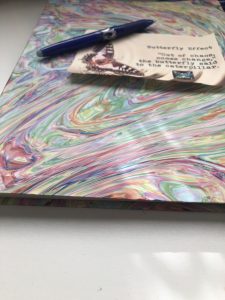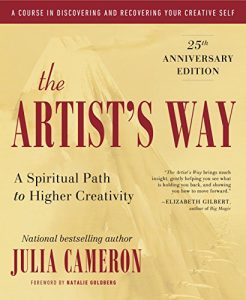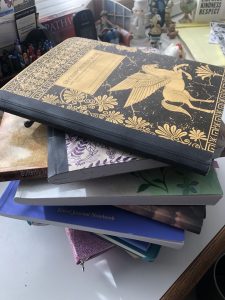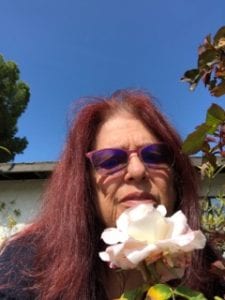In Which Trina Clarifies the Difference Between Journals vs. Diaries, and Shares Her Personal Journaling Journey
By Trina O’Quinn for the NABBW
 In reviewing the blogs that I have written over the last year and a half, I have discovered they have some common themes.
In reviewing the blogs that I have written over the last year and a half, I have discovered they have some common themes.
These themes are:
– The Pandemic
– Change
– Loss
– Grief
In some of my posts, I have shared the thoughts and feelings I have had while dealing with these issues. But I have not discussed the major tool/process that I have used for the last 29 years, which is journaling.
To begin with, I want to be clear that journaling should not be confused with keeping a diary, though they ARE often confused with each other. Sometimes the concept is interchanged. Yet, in reality, there is a big difference between the two because they serve different purposes.
Diaries are a way to track data in a disciplined manner. They are structured. They are formatted in many specific ways, often by days, months, years. They can be used to track a variety of things: food/water intake, appointments, weight, moods, exercise, health symptoms, etc. While diaries and journals can be used to collect similar information, diaries are much more structured and dictate what is written.
Journals, on the other hand, are used for a variety of purposes such as exploring thoughts, feelings, and ideas. Journals begin as blank pages, either lined or unlined. They can be a bound book or a package of notebook paper. This allows the journal keeper to create any structure they want in their pages. Journals are often used for creative purposes and are ideal for jotting down notes on travel, ideas, thoughts dreams, goals, bucket lists, gratitude lists, or anything you need or want to write down. When you want to write for these purposes, the more strict structure of a diary would be too stifling.
In this blog post, I am going to talk about my personal journey using journaling.
In 1992, at the age of 47, I found myself emotionally lost. I had been a college student of a good portion of my adult life. I had returned to school 16 years before to finish my bachelor’s degree. As it turned out, I continued until I had a Certification in Chemical Dependency, a master’s degree and a California State License in Marriage and Family Therapy. This journey had consumed what personal time I had. My life was school and family. I had left behind all creative arts and personal friends. I had achieved my goals and started a private practice in psychotherapy. Besides not knowing how to run a business, I felt like there was something missing in my life.
 It was at that time I was introduced to the book The Artist Way: A Spiritual Path To Higher Creativity by Julia Cameron. It is a twelve-week course to help the student reconnect with their creativity. It taught me two pivotal tools: 1) the morning pages and 2) the artist date. The rest of this blog will be centered on the morning pages, what they are and how they inspired me to keep journaling.
It was at that time I was introduced to the book The Artist Way: A Spiritual Path To Higher Creativity by Julia Cameron. It is a twelve-week course to help the student reconnect with their creativity. It taught me two pivotal tools: 1) the morning pages and 2) the artist date. The rest of this blog will be centered on the morning pages, what they are and how they inspired me to keep journaling.
What are morning pages? Simply morning pages are three pages of longhand writing, strictly stream-of-though consciousness. Mine usually start out with, “Good morning and thank you for one more day.” Julia has nicknamed them the “Brain Drain,” since that is one of their many functions. There is no wrong way to do morning pages. These are not supposed to be works of art or perfect copy. Do not correct spelling or ideas, just write the chatter in your head.
 There are two rules: 1) that they are done the first thing in the morning and 2) that you write three pages or a minimum of 20 minutes. It does not matter the size of the page; I fill a minimum of three college-ruled pages daily. The content is whatever comes from the brain through the arm and hand onto the paper.
There are two rules: 1) that they are done the first thing in the morning and 2) that you write three pages or a minimum of 20 minutes. It does not matter the size of the page; I fill a minimum of three college-ruled pages daily. The content is whatever comes from the brain through the arm and hand onto the paper.- I have had song lyrics appear, poems, and drawn picture along with word that described thoughts and feelings I was not aware of having. I’ve discovered dreams that I was unaware of and come to major decisions through this ritual.
- I have been consistently writing these pages since 1992. I’ve missed a few days and always come back to the pages when I don’t know what is going on within my heart or brain.
 During this pandemic, morning pages and other journaling have kept me sane, balanced, centered, focused, and grounded. Morning pages can be done anywhere. I have done them as a passenger on road trips, but I prefer my office or dining room table because they both have a window facing my front yard. That way when the ideas stop flying, I can stare out into space and continue waiting until I complete three pages or 20 minutes have passed. When the words are not flowing, I take a deep breath and ask myself in the journal, “Why are you having trouble writing today?” After this, and many years of writing morning pages, the answer usually appears on the page.
During this pandemic, morning pages and other journaling have kept me sane, balanced, centered, focused, and grounded. Morning pages can be done anywhere. I have done them as a passenger on road trips, but I prefer my office or dining room table because they both have a window facing my front yard. That way when the ideas stop flying, I can stare out into space and continue waiting until I complete three pages or 20 minutes have passed. When the words are not flowing, I take a deep breath and ask myself in the journal, “Why are you having trouble writing today?” After this, and many years of writing morning pages, the answer usually appears on the page.
I do not share the totality of these pages with anyone. I destroy them after I have bullet pointed my ideas, answers, and dreams. The process is mine. The pages give me me-time wherever I happen to be. This ritual helps me check in with myself at least once a day. It definitely keeps both my anxiety and depression in check. It also gives me ideas to expand on in my blogs.
My next blog will discuss the different ways Journals can be kept and how they might be used
 Trina O’Quinn was an actively licensed (California License # LMFT27407) Marriage and Family Therapist. Entering the profession as an older adult, Trina was in private practice for 30 years. During her career, she was a lecturer at California University Dominguez Hills, in the Marital and Family Therapy Program, where she supervised many students and mentored many associates.
Trina O’Quinn was an actively licensed (California License # LMFT27407) Marriage and Family Therapist. Entering the profession as an older adult, Trina was in private practice for 30 years. During her career, she was a lecturer at California University Dominguez Hills, in the Marital and Family Therapy Program, where she supervised many students and mentored many associates.
Now retired, Trina keeps busy enjoying needle arts, reading, journaling and writing, as well as singing with a women’s chorus, peer networking, volunteering at a senior living center and reconnecting with old friends.


